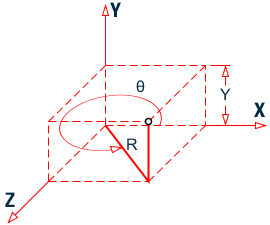G.4.1 Global Coordinate System
The following coordinate systems are available for specification of the structure geometry.
- Conventional Cartesian Coordinate System
-
This coordinate system is a rectangular coordinate system (X, Y, Z) which follows the orthogonal right hand rule. This coordinate system may be used to define the joint locations and loading directions.
- Cylindrical Coordinate System
-
In this coordinate system, the X and Y coordinates of the conventional Cartesian system are replaced by R (radius) and Ø (angle in degrees). The Z coordinate is identical to the Z coordinate of the Cartesian system and its positive direction is determined by the right hand rule.
- Reverse Cylindrical Coordinate System
-
This is a cylindrical type coordinate system where the R- Ø plane corresponds to the X-Z plane of the Cartesian system. The right hand rule is followed to determine the positive direction of the Y axis.



